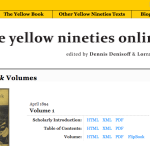
The Moonstone, Harper’s Weekly, 1868-05-23. Image digitized by Melanie Radford, courtesy of Special Collections, University of Calgary Library.
By Karen Bourrier
In my senior seminar on “The Victorian Bestseller,” we’ve just finished a big class project. When I found out that our Special Collections at the University of Calgary holds both of the periodicals in which Wilkie Collins’s The Moonstone (1868) was originally serialized–Harper’s Weekly in the U.S. and All the Year Round in the UK–the opportunity to get students into rare books and thinking about the material culture of the text was too good to pass up. In conjunction with Special Collections, the assignment I devised asked each student to take on one of the thirty-two parts The Moonstone originally appeared in, and to compare and contrast its publication in Harper’s and All the Year Round. Students selected and annotated about half a dozen images from the periodicals–which could be anything from advertisements, to illustrations, to the articles and fiction that appeared alongside the novel–to make an argument about the difference the publishing context makes to the reading experience. They then used Omeka to mount a digital exhibit showcasing what they had found in the archives. Our class archive now explores 13 out of 32 parts of the novel, leaving room for another class to try this project again.
The results were fascinating. Students found everything from advertisements for diamonds to articles on the colonies and knots and riddles–important contexts for a mystery story about a gem stolen from India! This project was both more work, and I think more rewarding, than the traditional research essay for all involved. It was only possible because of the tremendous support we had from Annie Murray, Kathryn Ranjit, and Catelynn Sahadath at the University of Calgary Library. Here are a few of my takeaways from the project:
- This project required a lot more organization on my part as instructor. I started planning with our Head of Special Collections, Annie Murray, back in July, and it took a lot of co-ordination to book time for students in rare books, the digitization studio, and in a special metadata session. By contrast, I just wrote the prompts for our final research paper in an hour yesterday afternoon.
- The project also took more time. We spent two class sessions on learning about Omeka and metadata, and I held extra office hours in case any technical problems cropped up for the students. Amazingly, other than some images being very slow to load, we didn’t have a lot of technical problems. But this also wasn’t a project where I felt comfortable just handing out the assignment and seeing what students turned in. (Actually, after having spent several years teaching writing, I don’t do that for essays either, but that’s another story!)
- Having a small class size (in this case thirteen students) was essential to the project’s success given the organizational challenges and demands for time. I haven’t yet figured out how I would do this with a larger class (for example, one of our Victorian literature survey classes that typically have 40 students). Suggestions?
- Although the technology turned out to be pretty easy for the students to navigate in the end, it was harder for them to complete the project without seeing an example. Many of us know what a successful essay looks like, but what does a successful digital exhibit look like? Hopefully, the next class won’t have this problem, since there are now many successful examples in our class archive!
- Many students found the project more meaningful than essays they’d written in the past. In our final wrap-up session, several students commented on how this project felt like it meant more since it was for a public audience online, and not just their professor reading it. They even asked me to let them know if they’d “done anything wrong” so that they could fix it. I’ve never had students ask to revise their papers for no extra credit before!
- I always build in the potential for anonymity when I require digital projects, but almost no one ever takes me up on it. One of the biggest thrills for students was seeing their projects indexed in a Google search, and students were also happy to have me tweet about it.
I want to stress that I still think writing research papers is essential to our discipline–my class is just starting to write their final research papers now. But it was a lot of fun to do something different, and it stretched both me and the students in new ways. Even if they’re not digital, I’d love to hear about assignments you’ve done in the Victorian studies classroom that depart from the traditional term paper. Let me know in the comments!


